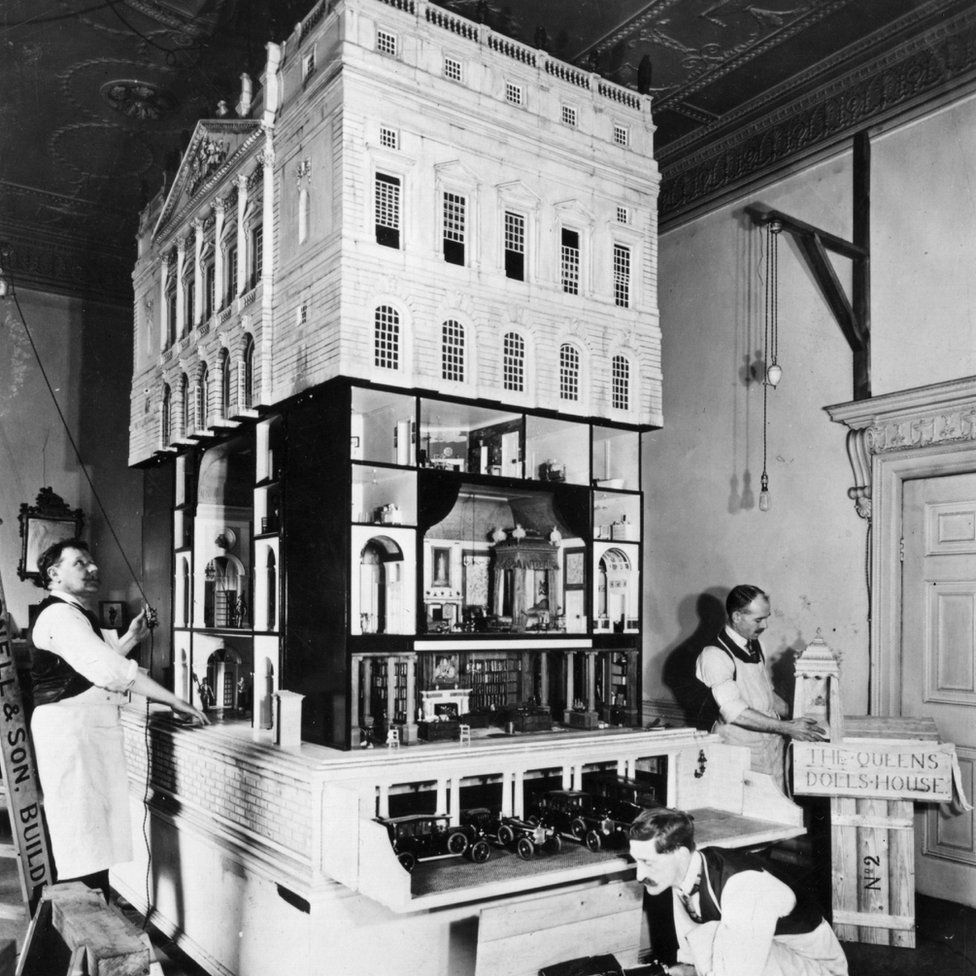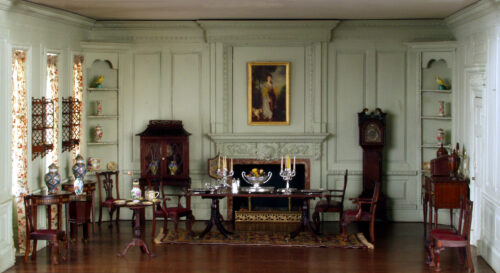By Emma Muhleman

Narcissa Niblack Thorne in her studio. Photo via Dollhouse Decorating.
In the basement of the Art Institute of Chicago, there are 68 miniature rooms. Each shoe-boxed size room was created on a one inch to 1 foot scale by Narcissa Niblack Thorne, and, in the quiet stillness of the displays, guests are transported to another time and place. The rooms model interior design throughout Europe, America, and Asia in different eras.

Cape Cod Living Room, 1750-1850. Photo via The Art Institute of Chicago.

English Drawing Room of the Georgian Period, 1800s. Photo via The Art Institute of Chicago.
Thorne had a lush childhood. She was born to a prosperous family in Indiana, before moving to Hyde Park, Chicago when she was eight. Thorne traveled extensively with her family in her youth, sparking her interest in European art and design. Her uncle, a Rear Admiral in the Navy, sent Thorne antique miniatures and trinkets every time the military stationed him somewhere new.
At 19 in 1901, Thorne married her childhood sweetheart James Ward Thorne, an heir to the Montgomery Ward department store fortune, one of the biggest in the world at the time. The pair later took a trip to Europe, where they visited Queen Mary’s Dollhouse, whose detail and precision would become immensely influential to Thorne. The dollhouse has working electricity, a library of fully printed books, a wine cellar stocked with real wine, among many other precisely detailed amenities.

Queen Mary’s Dollhouse. Photo via The BBC.
During the rest of the couple’s European holiday, Thorne began sourcing her own miniatures from antique stores and visited historical and architecturally important sites and homes. Upon their return, Thorne began renting a studio on Oak Street in the Gold Coast–it is said the couple’s own home had become overrun with miniatures before Thorne opened her studio– and set out to create her own series of miniature rooms inspired by her travels, depicting a visual history of interior design.
The first 12 rooms were all European homes with a focus on 18th century France. She gathered a team of skilled architects, designers, and craftsmen to help with the project. Thorne used the Great Depression to her advantage, while creating jobs for those out of work. Each member of Thorne’s team is honored with their own plaque in the Art Institute detailing their contributions to the rooms.
The first set of 26 rooms made their public debut at the Chicago World’s Fair in the Century of Progress exhibition, gaining mass amounts of attention. These rooms stayed touring and exhibiting for 30 years, before they went up for sale. Thorne’s son Niblack Thorne bought a portion of the rooms and donated them to the Phoenix Art Museum, where he was living. The rest of the first set resides in the Knoxville Art Museum.

Room from the first set located in Knoxville. Photo via Knoxville Art Museum.

Photo via Knoxville Art Museum.
In 1936, Thorne received a request to make a miniature library depicting a room at Windsor Castle for the coronation of Edward VIII, which she delivered in person. The coronation never occurred due to his abdication, but the mini library is still displayed at the Victoria and Albert Museum in London.
After creating the 68 rooms that can be seen in the Art Institute of Thorne Miniature Rooms Collection, the shortage of skilled artisans she could hire after the Great Depression ended led her to focus her work on dioramas and shadow boxes that were less time consuming. The permanent collection in the Art Institute was opened in 1954.

Photos via The Chicago Community Trust.
Thorne died in 1966, just months after closing her studio. She is buried in Rosehill Cemetery. In her will, Thorne set up a fund to cover the costs of caring for her works at the Art Institute. She never asked to receive any payment for her work and auctioned many rooms off for charity. She also donated a large sum of money to the Children’s Memorial Hospital.
Thorne’s two goals of the series were to educate on the history of decorative arts and educating in good taste, meaning aesthetics occasionally overtook accuracy. For most of the rooms, Thorne designed them using a real room as a guide, but she favored symmetry, straight lines and Parisian style, which she would frequently add even if the real counterpart did not have any of these stylistic elements.

California Hallway, 1940. Photo via The Art Institute of Chicago.
The rooms are painstakingly precise. When maintenance needs to be done to the rooms, only cotton swabs and tweezers can be used. The details leave guests awestruck, including windows with full outdoor scenes, miniscule keyholes in doors, a pair of eyeglasses or a porcelain cup of tea laying on the coffee table to make the room really seem lived in.
Visit the rooms at the Art Institute of Chicago to experience the wonder of these miniature rooms.







